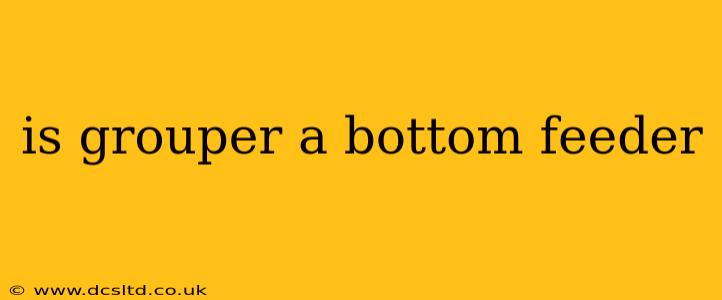Is Grouper a Bottom Feeder? Decoding the Dietary Habits of Grouper
The question of whether grouper is a bottom feeder is a common one, and the answer isn't a simple yes or no. While groupers are often found near the bottom of the ocean, their feeding habits are more complex than simply scavenging the seabed. Let's delve into their diet and habitat to understand their feeding strategies better.
What do groupers eat?
Groupers are carnivorous fish, meaning their diet consists primarily of other animals. Their specific diet can vary depending on their size, species, and the availability of prey in their environment. However, some common food sources include:
- Smaller fish: This is a major component of a grouper's diet, ranging from small schooling fish to larger, individual prey. They are ambush predators, often lying in wait to swiftly capture their meals.
- Crustaceans: Crabs, shrimp, and lobsters are all frequently consumed by groupers. Their powerful jaws allow them to crush the shells of these invertebrates.
- Cephalopods: Squid and octopus are also part of their menu, especially for larger grouper species.
- Echinoderms: Sea urchins and starfish are sometimes consumed, though not as frequently as other prey items.
Where do groupers live and hunt?
Groupers are found in a wide variety of marine habitats, including coral reefs, rocky areas, and seagrass beds. While they are frequently observed near the bottom, they don't exclusively feed there. They are opportunistic hunters, ambushing prey from various positions, including:
- Hidden amongst rocks and coral: This camouflage allows them to surprise their victims.
- Within crevices and caves: Offering them strategic ambush points.
- Mid-water column: Especially when hunting smaller, schooling fish.
Therefore, while groupers may frequent the bottom, characterizing them solely as "bottom feeders" is an oversimplification.
Do all grouper species feed in the same way?
No, the feeding habits can vary significantly among different grouper species. Some species may specialize in particular prey items or hunting strategies, while others display more generalist feeding habits. Size also plays a significant role; larger groupers can tackle larger prey than their smaller counterparts.
Are there any specific examples of grouper feeding behavior?
Many grouper species exhibit fascinating hunting techniques. Some use elaborate lures or cooperate with other species (like moray eels) to hunt more effectively. This strategic hunting, rather than simple scavenging, further distinguishes them from classic bottom feeders.
What are some examples of true bottom feeders?
To contrast, true bottom feeders typically consume decaying organic matter, detritus, and small organisms dwelling on the seafloor. Examples include certain types of catfish, rays, and some smaller fish species. Groupers, with their predatory behavior and diverse diet, don't fit this definition.
In conclusion:
While groupers often inhabit the ocean floor and may occasionally feed on organisms living there, they are not solely bottom feeders. They are active predators with a varied diet and sophisticated hunting strategies, making the term "bottom feeder" an inaccurate and overly simplistic description of their feeding ecology. They are opportunistic hunters utilizing various ambush techniques across different water columns.
